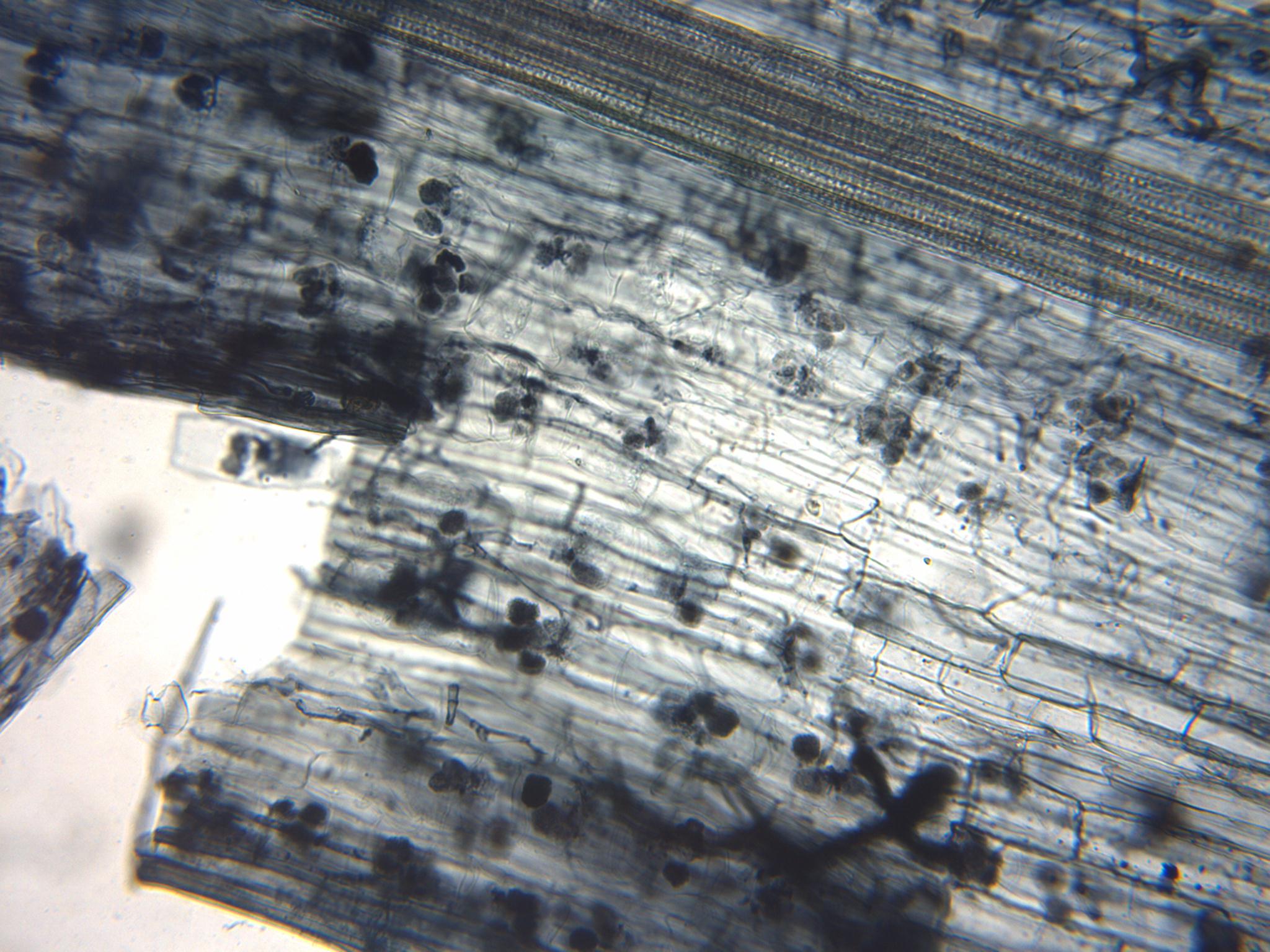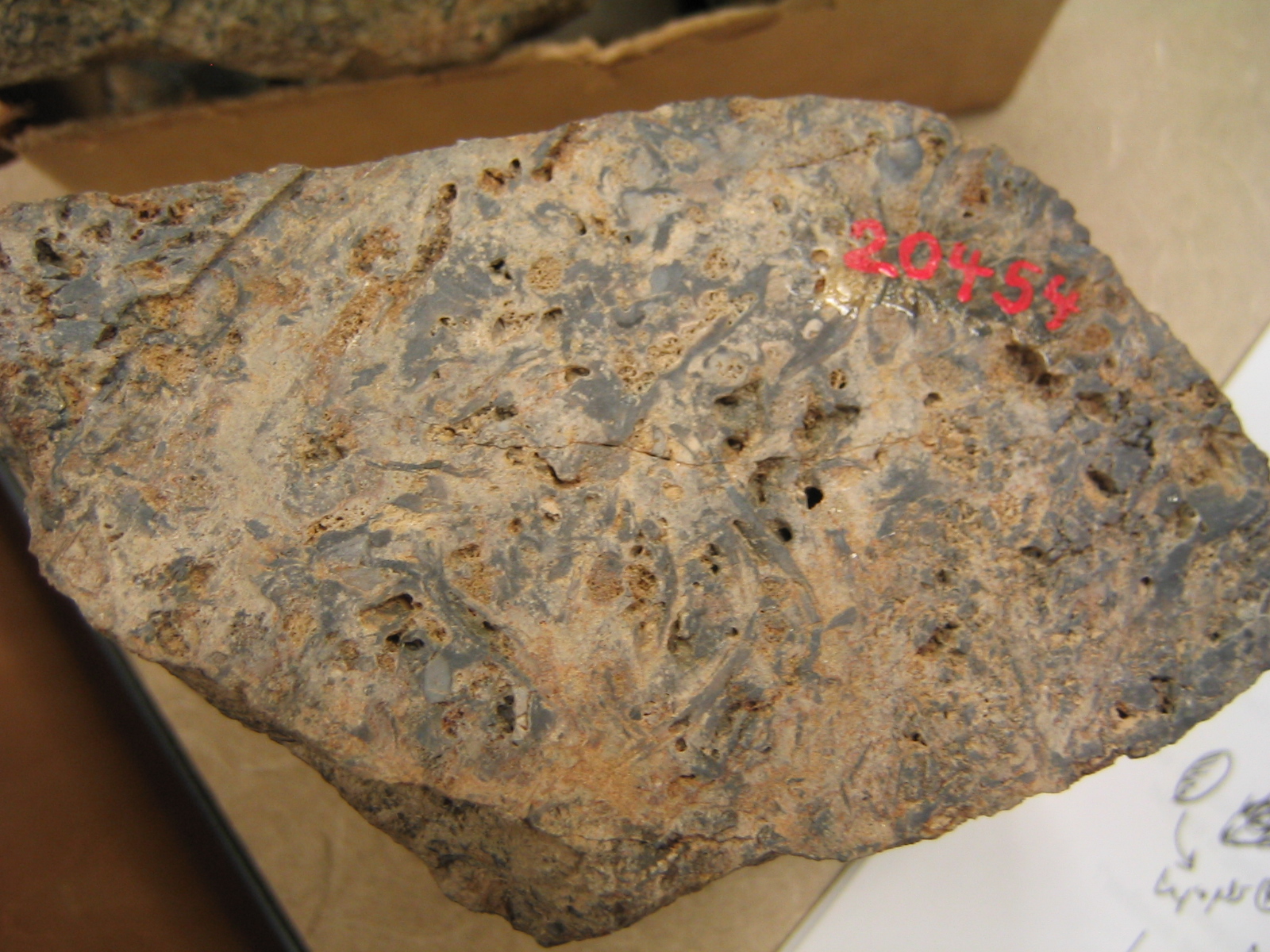|
Arbuscular Mycorrhizal Fungi
An arbuscular mycorrhiza (AM) (plural ''mycorrhizae'', a.k.a. ''endomycorrhiza'') is a type of mycorrhiza in which the symbiont fungus (''AM fungi'', or AMF) penetrates the cortical cells of the roots of a vascular plant forming arbuscules. (Not to be confused with ectomycorrhiza or ericoid mycorrhiza.) Arbuscular mycorrhizae are characterized by the formation of unique structures, arbuscules and vesicles, by Glomeromycota and Mucoromycota, sister clades of the more well-known and diverse dikaryan fungi (all three are together called "symbiomycota"). AM fungi help plants to capture nutrients such as phosphorus, sulfur, nitrogen and micronutrients from the soil. It is believed that the development of the arbuscular mycorrhizal symbiosis played a crucial role in the initial colonisation of land by plants and in the evolution of the vascular plants. It has been said that it is quicker to list the plants that do not form endomycorrhizae than those that do. This symbiosis is a ... [...More Info...] [...Related Items...] OR: [Wikipedia] [Google] [Baidu] |
Sulfur
Sulfur (or sulphur in British English) is a chemical element with the symbol S and atomic number 16. It is abundant, multivalent and nonmetallic. Under normal conditions, sulfur atoms form cyclic octatomic molecules with a chemical formula S8. Elemental sulfur is a bright yellow, crystalline solid at room temperature. Sulfur is the tenth most abundant element by mass in the universe and the fifth most on Earth. Though sometimes found in pure, native form, sulfur on Earth usually occurs as sulfide and sulfate minerals. Being abundant in native form, sulfur was known in ancient times, being mentioned for its uses in ancient India, ancient Greece, China, and ancient Egypt. Historically and in literature sulfur is also called brimstone, which means "burning stone". Today, almost all elemental sulfur is produced as a byproduct of removing sulfur-containing contaminants from natural gas and petroleum.. Downloahere The greatest commercial use of the element is the production o ... [...More Info...] [...Related Items...] OR: [Wikipedia] [Google] [Baidu] |
Devonian
The Devonian ( ) is a geologic period and system of the Paleozoic era, spanning 60.3 million years from the end of the Silurian, million years ago (Mya), to the beginning of the Carboniferous, Mya. It is named after Devon, England, where rocks from this period were first studied. The first significant adaptive radiation of life on dry land occurred during the Devonian. Free-sporing vascular plants began to spread across dry land, forming extensive forests which covered the continents. By the middle of the Devonian, several groups of plants had evolved leaves and true roots, and by the end of the period the first seed-bearing plants appeared. The arthropod groups of myriapods, arachnids and hexapods also became well-established early in this period, after starting their expansion to land at least from the Ordovician period. Fish reached substantial diversity during this time, leading the Devonian to often be dubbed the Age of Fishes. The placoderms began dominating ... [...More Info...] [...Related Items...] OR: [Wikipedia] [Google] [Baidu] |
Rhynie Chert
The Rhynie chert is a Lower Devonian sedimentary deposit exhibiting extraordinary fossil detail or completeness (a Lagerstätte). It is exposed near the village of Rhynie, Aberdeenshire, Scotland; a second unit, the Windyfield chert, is located some 700 m away. The Rhynie chert contains exceptionally preserved plant, fungus, lichen and animal material preserved in place by an overlying volcanic deposit. The bulk of the Devonian fossil bed consists of primitive plants (which had water-conducting cells and sporangia, but no true leaves), along with arthropods, lichens, algae and fungi. This fossil bed is remarkable for two reasons. First, the age of the site ( Pragian, Early Devonian, formed about ) places it at an early stage in the colonisation of land. Second, these cherts are famous for their exceptional state of ultrastructural preservation, with individual cell walls easily visible in polished specimens. Stomata have been counted and lignin remnants detected in the ... [...More Info...] [...Related Items...] OR: [Wikipedia] [Google] [Baidu] |
Paleobiological
Paleobiology (or palaeobiology) is an interdisciplinary field that combines the methods and findings found in both the earth sciences and the life sciences. Paleobiology is not to be confused with geobiology, which focuses more on the interactions between the biosphere and the physical Earth. Paleobiological research uses biological field research of current biota and of fossils millions of years old to answer questions about the molecular evolution and the evolutionary history of life. In this scientific quest, macrofossils, microfossils and trace fossils are typically analyzed. However, the 21st-century biochemical analysis of DNA and RNA samples offers much promise, as does the biometric construction of phylogenetic trees. An investigator in this field is known as a paleobiologist. Important research areas *Paleobotany applies the principles and methods of paleobiology to flora, especially green land plants, but also including the fungi and seaweeds (algae). See also myc ... [...More Info...] [...Related Items...] OR: [Wikipedia] [Google] [Baidu] |
Positive Effects Of Arbuscular Mycorrhizal (AM) Colonization
Positive is a property of positivity and may refer to: Mathematics and science * Positive formula, a logical formula not containing negation * Positive number, a number that is greater than 0 * Plus sign, the sign "+" used to indicate a positive number * Positive operator, a type of linear operator in mathematics * Positive result, a result that has been found significant in statistical hypothesis testing * Positive test, a diagnostic test result that indicates some parameter being evaluated was present * Positive charge, one of the two types of electrical charge * Positive (electrical polarity), in electrical circuits * Positive lens, in optics * Positive (photography), a positive image, in which the color and luminance correlates directly with that in the depicted scene * Positive sense, said of an RNA sequence that codes for a protein Philosophy and humanities * Affirmative (policy debate), the team which affirms the resolution * Negative and positive rights, concerning ... [...More Info...] [...Related Items...] OR: [Wikipedia] [Google] [Baidu] |
Agriculture
Agriculture or farming is the practice of cultivating plants and livestock. Agriculture was the key development in the rise of sedentary human civilization, whereby farming of domesticated species created food surpluses that enabled people to live in cities. The history of agriculture began thousands of years ago. After gathering wild grains beginning at least 105,000 years ago, nascent farmers began to plant them around 11,500 years ago. Sheep, goats, pigs and cattle were domesticated over 10,000 years ago. Plants were independently cultivated in at least 11 regions of the world. Industrial agriculture based on large-scale monoculture in the twentieth century came to dominate agricultural output, though about 2 billion people still depended on subsistence agriculture. The major agricultural products can be broadly grouped into foods, fibers, fuels, and raw materials (such as rubber). Food classes include cereals (grains), vegetables, fruits, cooking oils, meat, milk, ... [...More Info...] [...Related Items...] OR: [Wikipedia] [Google] [Baidu] |
Ecosystem Restoration
Restoration ecology is the scientific study supporting the practice of ecological restoration, which is the practice of renewing and restoring degraded, damaged, or destroyed ecosystems and habitats in the environment by active human interruption and action. Effective restoration requires an explicit goal or policy, preferably an unambiguous one that is articulated, accepted, and codified. Restoration goals reflect societal choices from among competing policy priorities, but extracting such goals is typically contentious and politically challenging. Natural ecosystems provide ecosystem services in the form of resources such as food, fuel, and timber; the purification of air and water; the detoxification and decomposition of wastes; the regulation of climate; the regeneration of soil fertility; and the pollination of crops. These ecosystem processes have been estimated to be worth trillions of dollars annually. There is consensus in the scientific community that the current env ... [...More Info...] [...Related Items...] OR: [Wikipedia] [Google] [Baidu] |
Ecosystem Management
Ecosystem management is an approach to natural resource management that aims to ensure the long-term sustainability and persistence of an ecosystems function and ecosystem service, services while meeting socioeconomic, political, and cultural needs. Although Indigenous peoples, indigenous communities have employed sustainable ecosystem management approaches for millennia, ecosystem management emerged formally as a concept in the 1990s from a growing appreciation of the complexity of ecosystems, as well as humans' reliance and influence on natural systems (e.g., Disturbance (ecology), disturbance, ecological resilience). Building upon traditional natural resource management, ecosystem management integrates ecological, socioeconomic, and institutional knowledge and priorities through diverse stakeholder participation. In contrast to command and control approaches to natural resource management, which often lead to declines in ecological resilience, ecosystem management is a holistic ... [...More Info...] [...Related Items...] OR: [Wikipedia] [Google] [Baidu] |
Glomalin
Glomalin is a glycoprotein produced abundantly on hyphae and spores of arbuscular mycorrhizal (AM) fungi in soil and in roots. Glomalin was discovered in 1996 by Sara F. Wright, a scientist at the USDA Agricultural Research Service. The name comes from Glomerales, an order of fungi. Most AM fungi are of the division Glomeromycota. An elusive substance, it is mostly known from its glue-like effect on soil and has not yet been isolated. Definition and controversy The specific protein glomalin has not yet been isolated and described. What has been described is an extraction process involving heat and citrate, producing mixture containing a substance that is reactive to a monoclonal antibody Mab32B11 raised against crushed AM fungi spores. The substance is then provisionally named "glomalin". As many laboratories do not have the equipment to perform an antibody-based isolation (ELISA), a crude mixture called glomalin-related soil proteins (GRSP) is used to refer to the extract port ... [...More Info...] [...Related Items...] OR: [Wikipedia] [Google] [Baidu] |
Ecology
Ecology () is the study of the relationships between living organisms, including humans, and their physical environment. Ecology considers organisms at the individual, population, community, ecosystem, and biosphere level. Ecology overlaps with the closely related sciences of biogeography, evolutionary biology, genetics, ethology, and natural history. Ecology is a branch of biology, and it is not synonymous with environmentalism. Among other things, ecology is the study of: * The abundance, biomass, and distribution of organisms in the context of the environment * Life processes, antifragility, interactions, and adaptations * The movement of materials and energy through living communities * The successional development of ecosystems * Cooperation, competition, and predation within and between species * Patterns of biodiversity and its effect on ecosystem processes Ecology has practical applications in conservation biology, wetland management, natural resource managemen ... [...More Info...] [...Related Items...] OR: [Wikipedia] [Google] [Baidu] |
Physiology
Physiology (; ) is the scientific study of functions and mechanisms in a living system. As a sub-discipline of biology, physiology focuses on how organisms, organ systems, individual organs, cells, and biomolecules carry out the chemical and physical functions in a living system. According to the classes of organisms, the field can be divided into medical physiology, animal physiology, plant physiology, cell physiology, and comparative physiology. Central to physiological functioning are biophysical and biochemical processes, homeostatic control mechanisms, and communication between cells. ''Physiological state'' is the condition of normal function. In contrast, ''pathological state'' refers to abnormal conditions, including human diseases. The Nobel Prize in Physiology or Medicine is awarded by the Royal Swedish Academy of Sciences for exceptional scientific achievements in physiology related to the field of medicine. Foundations Cells Although there are differ ... [...More Info...] [...Related Items...] OR: [Wikipedia] [Google] [Baidu] |






.jpg)